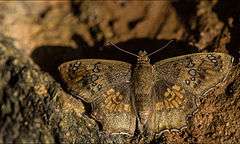Caprona ransonnettii
| Golden angle | |
|---|---|
 | |
| Wet-season form | |
| Scientific classification | |
| Kingdom: | Animalia |
| Phylum: | Arthropoda |
| Class: | Insecta |
| Order: | Lepidoptera |
| Family: | Hesperiidae |
| Genus: | Caprona |
| Species: | C. ransonnettii |
| Binomial name | |
| Caprona ransonnettii (Felder, 1868) | |
| Synonyms | |
| |
Caprona ransonnettii, commonly known as the golden angle, is a butterfly belonging to the family Hesperiidae.
Range
It occurs in Sri Lanka, Odisha and in the Nilgiri mountains.[1]
Description
For a key to the terms used, see Glossary of entomology terms.
In 1891, Edward Yerbury Watson gave this detailed description:
Upperside fuliginous ochreous-brown. Male; forewing with three small semi-transparent white spots before the apex (and sometimes one or two very minute spots obliquely below them), two spots within end of the cell, a slender spot between the upper and middle median veins, a larger spot between the latter vein and submedian, and followed below it by two small obliquely disposed spots; a marginal double row of pale indistinct small lunules; hindwing with a broad medial discal macular pale ochreous band traversed by brown veins and a spot within end of the cell, the outer discal area suffused with grey-brown. Cilia alternated with white. Female; forewing with the spots and marginal lunules, and the macular band on hindwing more prominent, the latter also more distinctly bordered with grey. Underside: forewing paler brown; the basal area greyish-white, the spots with clouded black outer borders; hindwing greyish-white, the outer margin only being brown, traversed by a curved discal series of small blackish spots.[1]The dry-season form which has been named A. taylorii by de Niceville differs in being ochreous not dark brown above, and in having the disc of the hindwing unmarked with a group of ochreous spots and streaks. A similar variation has been noted by Mr. de Niceville in C. tissa, a not very distantly allied species, and in both cases it is the dry-season form which is the paler.
— E.Y. Watson
References
This article is issued from Wikipedia - version of the 12/1/2016. The text is available under the Creative Commons Attribution/Share Alike but additional terms may apply for the media files.